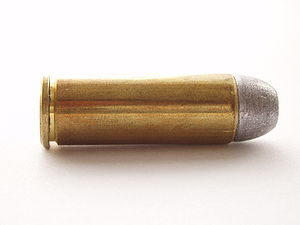 Lead is harmful, especially for children. Lowered IQ, learning disabilities, behavioral problems - all from lead exposure. There are no safe lead levels in individuals, so you want to avoid lead and lead-containing products whenever possible. So it shouldn't be a surprise that a study found that owning guns (firearms) is correlated with elevated lead levels in children.
Lead is harmful, especially for children. Lowered IQ, learning disabilities, behavioral problems - all from lead exposure. There are no safe lead levels in individuals, so you want to avoid lead and lead-containing products whenever possible. So it shouldn't be a surprise that a study found that owning guns (firearms) is correlated with elevated lead levels in children.
The cause is the lead ammunition (bullets) and primer used in the firearms. Lead styphnate is commonly used in the primer, which is the explosive that ignites the gunpowder. When a bullet is fired, fumes and fine lead particles are released into the air.
The researchers point out: When lead bullets are used, and the guns are discharged, then lead dust is produced. This lead dust gets everywhere, including on clothes, the body, personal items (e.g., phone, bags, laptop), and in vehicles. The lead dust is brought home, where it further settles on toys, the floor, rugs, and upholstery.
By the way, for hunters bringing home meat they killed with lead bullets - the lead (from tiny fragments or microscopic pieces) gets into the meat far from the bullet. So they are eating meat contaminated with lead. And the more of this meat is eaten, the higher the blood levels in the person.
Bottom line: Use non-lead bullets in firearms.
From Science Daily: Firearm ownership is correlated with elevated lead levels in children, study finds
Childhood lead exposure, primarily from paint and water, is a significant health concern in the United States, but a new study has identified a surprising additional source of lead exposure that may disproportionately harm children: firearms.
A team led by researchers at Brown University found an association between household firearm ownership and elevated lead levels in children's blood in 44 states, even when controlling for other major lead exposure sources.
Lead exposure from firearms is far less explored than from recognized sources like water or lead-based paint, but may be equally dangerous for children's health, said Christian Hoover, a Ph.D. candidate in epidemiology at Brown's School of Public Health, who is the lead author of the study published in the Journal of Pediatrics.
"This is very concerning because we don't have a system of monitoring lead from firearm use, as we do with residential paint, and there is no system in place to minimize or prevent children's exposure to lead in firearms," Hoover said. "Firearm use is a relatively unchecked source of childhood exposure to lead. There's currently no way to stop the exposure from happening and no interventions when it does."
In the study, the association between elevated lead levels and firearm use was almost as strong as the association for lead-based paint, Hoover noted.
Lead levels in children in the United States have been persistently high for decades. While public health measures have been put in place to prevent and reduce childhood lead poisoning from paint and drinking water, blood lead levels haven't concordantly dropped in significant measures, Hoover said.
Firearm-related take-home lead occurs when an individual discharges a firearm that uses lead-based ammunition and primer, which are the most commonly used in the United States, Hoover said. The lead dust settles on clothes and personal items, such as phones or bags, as well as in vehicles and common spaces. Children are more vulnerable to lead than adults due to their tendency to ingest contaminants through normal hand-to-mouth behaviors.
"Typically the places where the firearm-related lead collects, such as in carpets, are places where young children spend a considerable amount of time," said Hoover, who is a co-investigator at the Harvard Injury Control Research Center.
A previous study led by Hoover found a link between firearms and elevated lead levels in children's blood in cities and towns in Massachusetts; this new study involved the 44 U.S. states that report public health data on child blood lead levels.
Since there is no governmental database covering firearm ownership across states, the researchers used a widely-accepted proxy measure developed by the RAND Corporation to estimate state levels of household gun ownership. This metric combines data on firearm suicides, hunting licenses, subscriptions to Guns and Ammo magazine and background checks. They compared the data from the proxy measure with reports from the Centers for Disease Control and Prevention of blood lead concentration surveillance data for children under 6. The analysis spanned the years between 2012 and 2018.
According to the study, for every 10% increase in the number of households that report owning a gun, there is an approximate 30% increase in cases of elevated pediatric blood lead levels.
Childhood exposure to lead increases the risk of behavioral problems, reduced cognitive abilities and poor growth and development. There is no safe level of lead exposure, said Joseph Braun, a professor of epidemiology and director of the Center for Children's Environmental Health at Brown.
